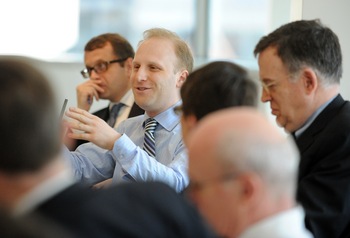
Prominent scholars, practitioners, and policy officials gather to discuss challenges presented by new banking rules.
For many in the financial world, the Volcker Rule seems to be an iron fist coming down on banks.
The rule, authorized by the Dodd-Frank Wall Street Reform and Consumer Protection Act of 2010, has two major parts: one banning proprietary trading by banking organizations and the other forbidding banking organizations from owning or sponsoring a private equity fund (or hedge fund), with a few narrow exceptions. According to some estimates, when finally implemented the rule could significantly impact the revenues of the nation’s largest banks.
To explore the challenges of implementing the Volcker Rule, the Penn Program on Regulation (PPR) and the law firm of Morrison & Foerster LLP recently hosted a roundtable discussion in Washington D.C. The roundtable brought together representatives from the financial industry, government, legal profession, and scholarly community for an intense discussion of the core challenges presented by the rule.
“Our aim is to make a useful contribution to the public discourse on the Volcker Rule,” said Charles Horn, a partner with Morrison & Foerster.
Roundtable participants stressed that, to understand the implementation of the Volcker Rule, it was necessary to understand its origins. During negotiations over the financial reform legislation, the Obama administration realized that the public demanded a stronger crackdown on Wall Street, so the administration changed from its initial opposition to the Volcker rule to announcing its support for the rule just two days after Republican Sen. Scott Brown (MA) won the race for Democrat Ted Kennedy’s former seat.
The Volcker Rule, its proponents observe, seeks to advance longstanding goals of promoting transparency and reduced risk in financial markets. Some have also claimed it will diminish risk taking within institutions that hold depositors’ funds or that benefit from government or taxpayer support.
After Dodd-Frank passed, federal regulators have moved to implement the Volcker Rule by initiating an administrative rulemaking. Last November, four financial regulatory agencies jointly issued a formal proposed rule that, together with its preamble, spanned nearly 300 typed pages and contained over 1,000 questions on which the government requested public comments.
Will this “lengthy, dense, and complex” proposed rule – to quote a Commissioner of the Securities and Exchange Commission – have its intended salutary effects on the banking industry and larger economy? Public commentators have offered a large number of substantive critiques of the agencies’ proposed rulemaking, which have highlighted a number of concerns about the legislative formulation of the Volcker Rule itself and about the agencies’ likely efforts to implement it.
“Interactive dialogue, like the kind fostered at the roundtable, can illuminate the many challenges and opportunities in implementing the Volcker Rule,” said Cary Coglianese, the director of the Penn Program on Regulation and a professor of law at the University of Pennsylvania.
In discussing the proposed rule, some roundtable participants expressed the concern that its complexity will impede the economy. As one of the participants colorfully observed about the myriad requirements likely to be imposed in the course of implementing the rule, “belts and suspenders can strangle you if your garment is not properly designed.”
One concern expressed at the roundtable was that the Volcker Rule’s limitation on proprietary trading – that is, on trading done for the bank’s own interest, not connected with any client transaction – may limit the market-making abilities of the banks that provide much-needed liquidity to the market. Market-making occurs when banks purchase less liquid assets when other buyers are not available. They later resell these assets when buyers are available. Regulators face a key challenge in distinguishing legitimate and economically valuable market-making activity from proprietary trading, which the Volcker Rule will prohibit.
In addition, some participants expressed concern about the Volcker Rule’s potential to complicate banks’ legitimate asset-liability and other risk management activities.
To distinguish permissible from impermissible trading, the Dodd-Frank Act appears to require an examination of the trader’s intent, but as other roundtable participants noted, regulators lack the ability to monitor traders’ brains to discern their intent. Regulators would need to find appropriate proxies for this intent requirement, but what these could be was not self-evident to a number of the roundtable participants.
Other participants observed that hedge funds are some of the only supporters of the Volcker Rule in the financial sector. As banks eliminate proprietary trading and reduce their market-making activities, hedge funds and other institutions in the shadow banking sector are likely to expand and pick up the slack in these types of market activities. Nevertheless, some participants worried that this sector will not be able to fill the massive void left in the market as banks reduce their trading activities, resulting in a net effect of reduced market liquidity.
Mirroring concerns of central banks around the world, a number of roundtable participants expressed concern about another unintended effect of the Volcker Rule: its interference with other countries’ financial regulation and its effect of limiting liquidity in international markets due to a spillover effect from the US markets.
Many participants recognized that the core challenge in implementing the Volcker Rule rests with the limits of legal rules. Financial markets are complex, so therefore rules governing market transactions tend to grow complex as well. But financial markets are also constantly changing, whereas complex and detailed systems of rules cannot adapt in real time.
Some roundtable participants favored the adoption of overarching principles and guidelines, rather than highly specific and rigid rules. For example, one participant suggested the adoption of a customer-orientation approach as a guiding principle. If a transaction is customer-oriented, then it would be permissible. Of course, even such a principles-based approach would likely require a definition or specification of what constitutes “customer-oriented.”
“Whether framed as broad principles or circumscribed prescriptions, the administrative rules implementing the Volcker Rule will not be easy ones to craft,” said Coglianese, an expert in regulatory law. “The Volcker Rule reveals how hard it can be to govern a dynamic industry through static legal rules,” he said.
In addition to the inherent limits of rules, financial regulation faces implementation challenges because the organizations it affects are large and complex. Activities that could be classified as proprietary trading do not necessarily occur within banking organizations at a unified “desk,” but rather occur as investments in different parts of the bank which rely on individuals who may rarely talk to each other.
Lags in information technology, according to some participants, have prevented banks from monitoring on their own the inter-relatedness of these diverse financial activities and the associated risks. Alternative solutions which aggregate firm data could identify systemic risks and therefore prevent excessive risk exposure through proprietary trading.
Although the Dodd-Frank Act requires the legislative formulation of the Volcker Rule to go into effect on July 21, 2012, the administrative regulations to implement the rule will likely not be ready by that date, according to a recent statement by the Federal Reserve Chair, Ben Bernanke. The Fed has also recently announced that it will not enforce the Volcker Rule until July, 2014, providing further indication of the time it will take before the rule is fully implemented.
Regardless of the Volcker Rule’s circuitous path to implementation, many roundtable participants seemed to agree that the rule needs ultimately to lead banking institutions to think thoroughly about their entire institution’s financial risks, encouraging improvements in holistic risk-management for banking activities rather than scattering such activities throughout these very large financial institutions.
PPR Director Coglianese moderated the roundtable, which featured opening presentations by PPR faculty affiliates Jill Fisch, Richard Herring, and David Skeel, and opening comments by Morrison & Foerster partners Charles Horn, Oliver Ireland, and Dwight Smith.



